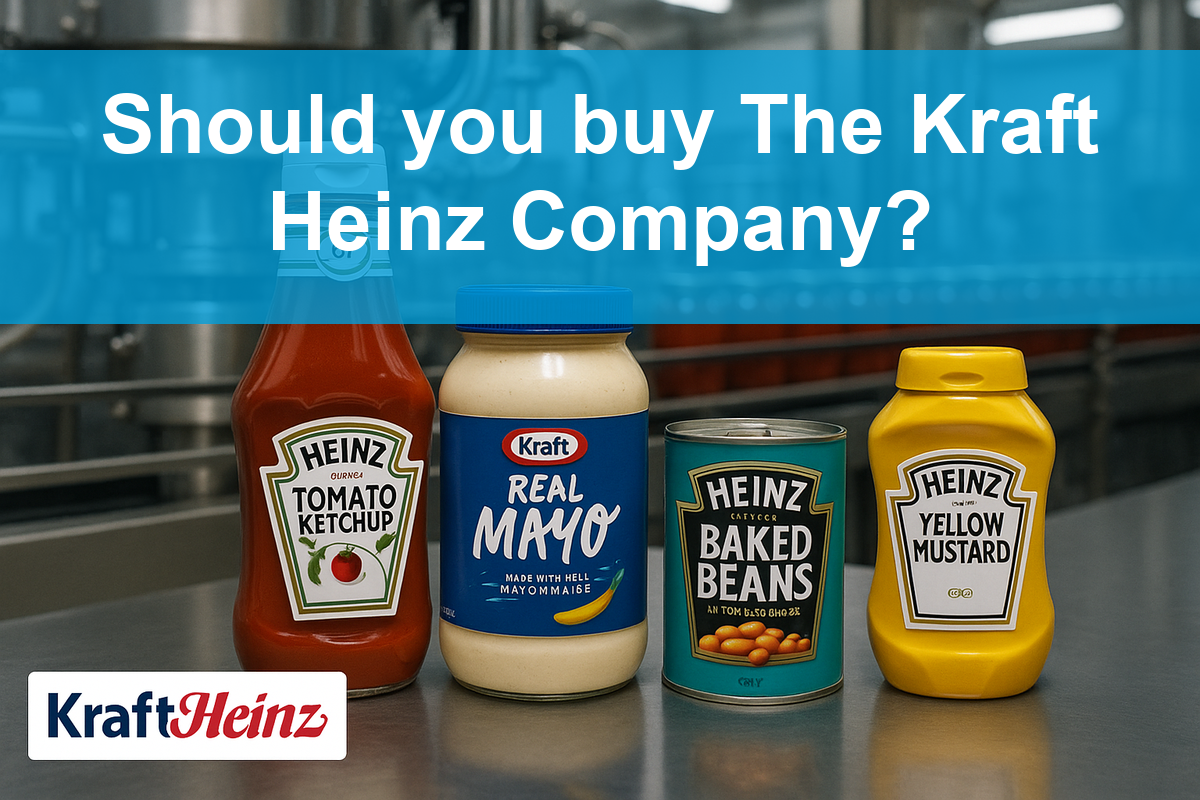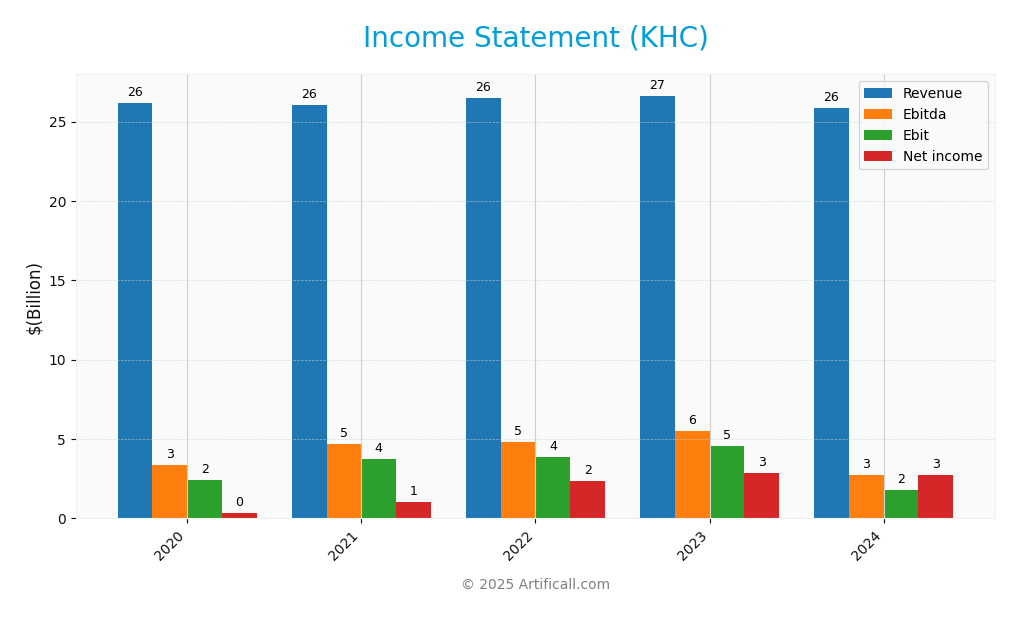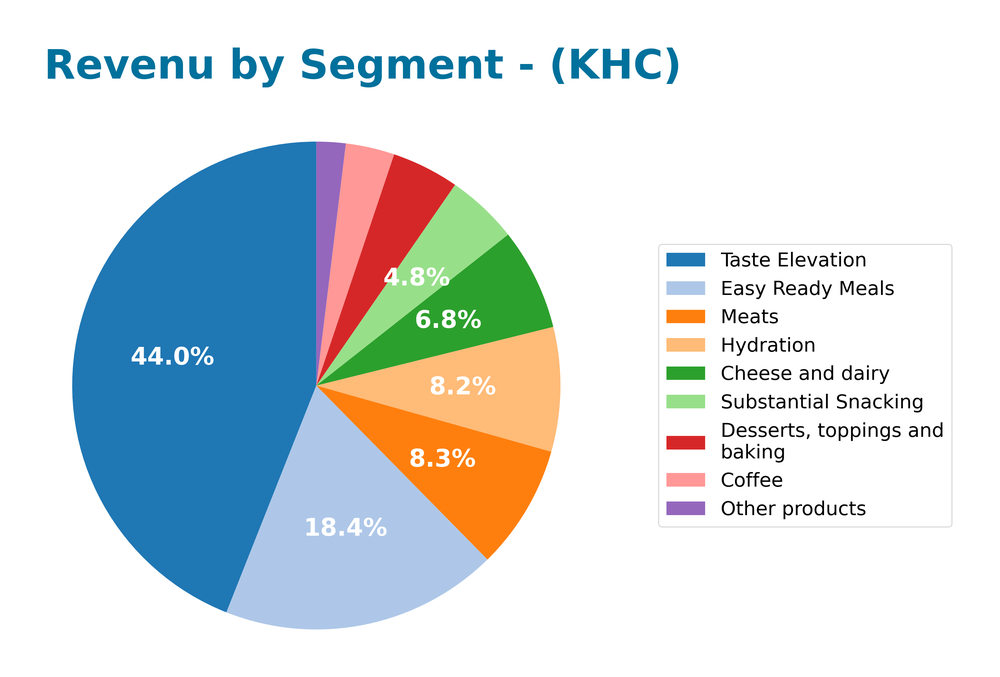Imagine a world where your favorite meals come alive with the touch of a bottle or a sprinkle of seasoning. The Kraft Heinz Company is at the forefront of this culinary transformation, driving innovation in the packaged foods industry. With beloved products ranging from iconic condiments to nutritious snacks, Kraft Heinz is shaping how we eat and experience food every day. As we delve into their current financial standing, I invite you to consider: do the fundamentals of Kraft Heinz still support its market valuation and growth prospects?

Table of contents
Company Description
The Kraft Heinz Company (KHC), founded in 1869 and headquartered in Pittsburgh, Pennsylvania, is a prominent player in the packaged foods industry, boasting a market cap of approximately $29.4B. The company produces a diverse range of food and beverage products, including condiments, dairy, meals, meats, and snacks, catering primarily to markets in the U.S., Canada, and the U.K. With around 36K employees, Kraft Heinz operates through various sales channels, from grocery stores to online platforms. As a leader in its sector, Kraft Heinz is strategically positioned to innovate and adapt within the evolving landscape of consumer preferences and sustainability initiatives, playing a pivotal role in shaping the future of food consumption.
Fundamental Analysis
In this section, I will conduct a fundamental analysis of The Kraft Heinz Company, focusing on its income statement, financial ratios, and dividend payout policy.
Income Statement
The following table summarizes the income statement of The Kraft Heinz Company (KHC) over the last five fiscal years, highlighting key financial metrics.

| Metric | 2020 | 2021 | 2022 | 2023 | 2024 |
|---|---|---|---|---|---|
| Revenue | 26.2B | 26.0B | 26.5B | 26.6B | 25.8B |
| Cost of Revenue | 17.0B | 17.4B | 18.4B | 17.7B | 16.9B |
| Operating Expenses | 7.0B | 5.2B | 4.5B | 4.4B | 7.3B |
| Gross Profit | 9.2B | 8.7B | 8.1B | 8.9B | 8.9B |
| EBITDA | 3.4B | 2.4B | 4.8B | 5.5B | 2.7B |
| EBIT | 2.4B | 3.8B | 3.9B | 4.5B | 1.8B |
| Interest Expense | 1.4B | 2.0B | 0.9B | 0.9B | 0.9B |
| Net Income | 0.4B | 1.0B | 2.4B | 2.9B | 2.7B |
| EPS | 0.29 | 0.83 | 1.93 | 2.33 | 2.27 |
| Filing Date | 2021-02-17 | 2022-02-17 | 2023-02-16 | 2024-02-15 | 2025-02-13 |
Over the five-year period, KHC’s revenue showed a slight decline, peaking in 2023 at 26.6B before dropping to 25.8B in 2024. However, net income fluctuated positively, reaching a peak of 2.9B in 2023 but slightly decreasing to 2.7B in 2024. The gross profit margin remained stable, reflecting effective cost management despite increased operating expenses in the latest fiscal year. The decline in EBITDA in 2024 indicates potential challenges in maintaining operational efficiency, which warrants careful monitoring moving forward.
Financial Ratios
The following table summarizes the key financial ratios for The Kraft Heinz Company (KHC) over the last five years.
| Ratios | 2020 | 2021 | 2022 | 2023 | 2024 |
|---|---|---|---|---|---|
| Net Margin | 1.36% | 3.89% | 8.92% | 10.72% | 10.62% |
| ROE | 0.71 | 0.77 | 0.74 | 0.84 | 0.75 |
| ROIC | 0.09 | 0.11 | 0.12 | 0.14 | 0.14 |
| P/E | 119.07 | 43.42 | 21.12 | 15.89 | 13.53 |
| P/B | 0.85 | 0.89 | 1.03 | 0.92 | 0.75 |
| Current Ratio | 1.34 | 0.99 | 0.87 | 0.99 | 1.06 |
| Quick Ratio | 0.99 | 0.69 | 0.47 | 0.54 | 0.59 |
| D/E | 0.565 | 0.443 | 0.412 | 0.404 | 0.404 |
| Debt-to-Assets | 0.284 | 0.234 | 0.222 | 0.222 | 0.225 |
| Interest Coverage | 1.53 | 1.69 | 3.95 | 5.01 | 1.85 |
| Asset Turnover | 0.26 | 0.28 | 0.29 | 0.29 | 0.29 |
| Fixed Asset Turnover | 3.81 | 3.83 | 3.93 | 3.74 | 3.61 |
| Dividend Yield | 4.62% | 4.46% | 3.93% | 4.33% | 5.20% |
Interpretation of Financial Ratios
In the most recent year (2024), Kraft Heinz shows a stable net margin (10.62%) and a low price-to-earnings (P/E) ratio (13.53), indicating a potentially undervalued stock. However, the current ratio at 1.06 suggests a marginal liquidity position, raising concerns about short-term obligations. Additionally, the declining interest coverage ratio (1.85) indicates potential challenges in servicing debt, which warrants caution.
Evolution of Financial Ratios
Over the past five years, Kraft Heinz’s financial ratios reveal an overall improvement in profitability, particularly in net margin and dividend yield. However, liquidity ratios have shown volatility, with the current ratio fluctuating around the critical level of 1, indicating ongoing liquidity concerns.
Distribution Policy
The Kraft Heinz Company (KHC) maintains a dividend payout ratio of approximately 70%, reflecting a commitment to return capital to shareholders. The annual dividend yield stands at around 5.2%, supported by free cash flow. However, potential risks include unsustainable distributions in a challenging market and the impact of high debt levels. KHC also engages in share buybacks, which can enhance shareholder value but may divert funds from other strategic investments. Overall, KHC’s distribution strategy appears to support long-term value creation, albeit with caution warranted.
Sector Analysis
The Kraft Heinz Company operates in the packaged foods industry, offering a diverse range of products including condiments, dairy, and snacks, while competing against major players like Unilever and Nestlé. Its competitive advantages include strong brand recognition and extensive distribution networks.
Strategic Positioning
The Kraft Heinz Company (KHC) holds a substantial position in the packaged foods industry, boasting a market cap of approximately $29.41B. The company has a diverse product portfolio, including condiments, dairy, and snack foods, which contributes to its competitive edge. However, it faces significant competitive pressure from rivals, particularly as consumer preferences shift towards healthier options. Technological disruption in food production and e-commerce also presents challenges, pushing KHC to innovate and adapt. With a beta of just 0.076, KHC reflects stability in a volatile market, but investors should remain cautious of market dynamics and evolving consumer trends.
Revenue by Segment
The pie chart below illustrates The Kraft Heinz Company’s revenue by segment for the fiscal year 2024, showcasing the company’s diverse product portfolio.

In fiscal year 2024, The Kraft Heinz Company experienced notable revenue generation across its segments, with “Taste Elevation” leading at 11.37B, followed by “Easy Ready Meals” at 4.75B and “Meats” at 2.14B. While “Cheese and dairy” and “Coffee” held significant positions, both showed a decline compared to previous years, indicating potential challenges in those areas. The overall revenue growth in 2024 appears to have slowed relative to prior fiscal years, raising concerns about margin pressures and the risks associated with over-reliance on specific segments.
Key Products
The following table outlines the key products offered by The Kraft Heinz Company, showcasing their diverse portfolio in the packaged foods industry.
| Product | Description |
|---|---|
| Ketchup | A popular condiment made from tomatoes, vinegar, and spices, widely used in various dishes. |
| Kraft Singles | Processed cheese slices that are convenient for sandwiches and snacks, appealing to families. |
| Heinz 57 Sauces | A versatile sauce blend used for grilling and marinating, enhancing the flavor of meats and vegetables. |
| Lunchables | Ready-to-eat meal kits that include a variety of meats, cheeses, crackers, and desserts, targeted at children. |
| Velveeta | A brand of processed cheese product known for its creamy texture, often used in recipes or as a dip. |
| Jello | A sweet gelatin dessert available in multiple flavors, popular for both adults and children. |
| Classico Pasta Sauce | Gourmet pasta sauces made with high-quality ingredients, designed for Italian cuisine enthusiasts. |
| Capri Sun | A brand of juice drink packaged in pouches, popular among children and families for on-the-go consumption. |
| Heinz Beans | Baked beans in tomato sauce, a classic comfort food that is a staple in many households. |
| Kraft Mac & Cheese | A convenient and quick meal option featuring macaroni pasta and cheese sauce, beloved by many. |
Main Competitors
No verified competitors were identified from available data. However, The Kraft Heinz Company (KHC) holds a significant position in the packaged foods industry, with an estimated market share of approximately 4.5% in the U.S. market. The company’s competitive strength lies in its diverse product offerings, including condiments, sauces, dairy products, and snacks, positioning it as a key player in the consumer defensive sector.
Competitive Advantages
The Kraft Heinz Company (KHC) possesses significant competitive advantages, primarily due to its vast product portfolio and strong brand recognition in the packaged foods industry. With a market cap of approximately 29.4B and a diversified range of offerings, including condiments, dairy, and healthy snacks, KHC is well-positioned. Looking ahead, the company is exploring new product lines focused on health-conscious consumers and expanding into emerging markets. Additionally, KHC’s robust distribution network enables it to reach various channels effectively, enhancing its market presence and growth opportunities.
SWOT Analysis
This SWOT analysis provides insights into The Kraft Heinz Company’s current position and future potential.
Strengths
- Strong brand recognition
- Diverse product portfolio
- Global market presence
Weaknesses
- High debt levels
- Dependence on retail partners
- Limited innovation in some categories
Opportunities
- Growth in plant-based products
- Expansion in emerging markets
- Increasing demand for convenience foods
Threats
- Intense competition
- Fluctuating commodity prices
- Changing consumer preferences
The overall SWOT assessment indicates that while Kraft Heinz has significant strengths and opportunities, it must address its weaknesses and remain vigilant against external threats. A strategic focus on innovation and market expansion will be crucial for sustaining its competitive edge.
Stock Analysis
Over the past year, The Kraft Heinz Company’s (KHC) stock has experienced significant price movements, culminating in a marked decline that reflects ongoing trading dynamics.

Trend Analysis
Analyzing KHC’s stock over the past two years reveals a substantial percentage change of -31.66%. This indicates a clear bearish trend. The stock’s highs and lows were recorded at 38.16 and 24.28, respectively, with the trend showing signs of deceleration. The standard deviation of 4.01 suggests a moderate level of volatility in the stock’s price movements.
Volume Analysis
In the last three months, the average trading volume for KHC has been approximately 82.9M, characterized by a buyer-seller dynamic that leans towards seller dominance. The average buy volume stands at 21.9M, while the average sell volume is significantly higher at 61.0M. This trend, coupled with a bullish volume trend, indicates increasing market participation but suggests cautious investor sentiment as sellers outpace buyers.
Analyst Opinions
Recent analyst recommendations for The Kraft Heinz Company (KHC) show a consensus to hold, with a B- rating from analysts. Key arguments highlight concerns regarding return on equity and assets, which scored low at 1. However, the company’s discounted cash flow score is strong at 5, indicating potential for future growth. Analysts suggest monitoring KHC’s debt-to-equity ratio and price-to-book value, which scored a more favorable 2 and 4 respectively. Given the current landscape, I recommend cautious optimism while weighing the risks.
Stock Grades
The latest stock ratings for The Kraft Heinz Company (KHC) indicate a consensus among major grading companies to maintain their current positions.
| Grading Company | Action | New Grade | Date |
|---|---|---|---|
| Barclays | Maintain | Equal Weight | 2025-10-31 |
| UBS | Maintain | Neutral | 2025-10-30 |
| Piper Sandler | Maintain | Neutral | 2025-10-30 |
| Wells Fargo | Maintain | Equal Weight | 2025-10-30 |
| TD Cowen | Maintain | Hold | 2025-10-30 |
| Evercore ISI Group | Maintain | In Line | 2025-10-30 |
| JP Morgan | Maintain | Neutral | 2025-10-30 |
| Mizuho | Maintain | Neutral | 2025-10-28 |
| UBS | Maintain | Neutral | 2025-10-08 |
| Wells Fargo | Maintain | Equal Weight | 2025-09-03 |
Overall, the trend in grades shows a stable outlook, with several companies maintaining their previous ratings of Neutral or Equal Weight. This suggests a cautious sentiment around KHC, indicating that analysts see the stock as stable but not significantly undervalued or overvalued at this time.
Target Prices
The current consensus for The Kraft Heinz Company (KHC) indicates a balanced outlook among analysts.
| Target High | Target Low | Consensus |
|---|---|---|
| 28 | 24 | 26 |
Analysts expect KHC to trade around a consensus target of 26, reflecting a moderate level of confidence in the stock’s performance.
Consumer Opinions
Consumer sentiment about The Kraft Heinz Company (KHC) reveals a mixed bag of experiences, reflecting both satisfaction and areas needing improvement.
| Positive Reviews | Negative Reviews |
|---|---|
| “Great taste and variety in products!” | “Prices have increased too much lately.” |
| “Convenient and easy meal options.” | “Customer service could be better.” |
| “High-quality ingredients in their foods.” | “Some flavors are inconsistent.” |
Overall, consumer feedback highlights the strength of product taste and variety, while concerns about pricing and customer service persist as weaknesses.
Risk Analysis
In evaluating The Kraft Heinz Company (KHC), it is crucial to consider various risks that may affect its performance. Below is a table summarizing these risks:
| Category | Description | Probability | Impact |
|---|---|---|---|
| Supply Chain | Disruptions due to geopolitical tensions or pandemics | High | High |
| Market Competition | Increased competition from plant-based and healthier alternatives | Medium | High |
| Regulatory | Changes in food safety regulations impacting production | Medium | Medium |
| Economic | Inflation affecting consumer spending and pricing | High | Medium |
| Brand Reputation | Negative publicity could harm consumer perception | Medium | High |
In my analysis, supply chain disruptions and market competition are the most likely and impactful risks for KHC, particularly given recent inflationary pressures and evolving consumer preferences towards healthier options.
Should You Buy The Kraft Heinz Company?
The Kraft Heinz Company (KHC) showcases a solid net profit margin of 10.62% and a positive return on invested capital (ROIC) of 4.57%, albeit slightly below its weighted average cost of capital (WACC) of 4.11%. The company benefits from a strong brand portfolio and significant economies of scale but faces recent risks, including intensified competition and a bearish long-term trend.
Given that the net margin is above zero but the ROIC is not exceeding the WACC, and considering the bearish long-term trend and seller-dominant volume behavior, I would recommend waiting for a more favorable environment before considering an investment. It would be prudent to monitor for signs of a bullish reversal and improved fundamental performance before making any decisions.
Specific risks for Kraft Heinz include competitive pressures in the food and beverage sector, potential supply chain disruptions, and challenges related to valuation in a fluctuating market.
Disclaimer: This article is not financial advice. Each investor is responsible for their own investment decisions.
Additional Resources
- Vise Technologies Inc. Acquires Shares of 20,940 Kraft Heinz Company $KHC – MarketBeat (Nov 16, 2025)
- Kraft Heinz: Wait For The Split Before Taking Action – Seeking Alpha (Nov 12, 2025)
- Why The Kraft Heinz Company (KHC) Appeals to Income Investors Seeking Strong Yields – Yahoo Finance (Oct 01, 2025)
- Kraft Heinz Company $KHC Shares Acquired by Geode Capital Management LLC – MarketBeat (Nov 16, 2025)
- Kraft Heinz: Shares Continue To Melt – Sell (NASDAQ:KHC) – Seeking Alpha (Nov 14, 2025)
For more information about The Kraft Heinz Company, please visit the official website: kraftheinzcompany.com



